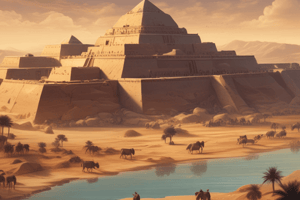Podcast
Questions and Answers
What is the name of the writing system developed in Mesopotamia?
What is the name of the writing system developed in Mesopotamia?
- Logographic
- Hieroglyphics
- Alphabetic
- Cuneiform (correct)
Which river runs along the location of Ancient Egypt?
Which river runs along the location of Ancient Egypt?
- Euphrates
- Indus
- Nile (correct)
- Tigris
What is the name of the famous code of laws developed in Mesopotamia?
What is the name of the famous code of laws developed in Mesopotamia?
- Code of Hammurabi (correct)
- Babylonian Constitution
- Law of the Pharaohs
- Mesopotamian Charter
Which period in Ancient Egypt is characterized by the construction of pyramids and strong pharaohs?
Which period in Ancient Egypt is characterized by the construction of pyramids and strong pharaohs?
What is the name of the temples found in Mesopotamia?
What is the name of the temples found in Mesopotamia?
Which Mesopotamian civilization is known for its law code and irrigated agriculture?
Which Mesopotamian civilization is known for its law code and irrigated agriculture?
What characterized city-states in Mesopotamia?
What characterized city-states in Mesopotamia?
What was a key feature of early agricultural practices?
What was a key feature of early agricultural practices?
What was the impact of agriculture on societies?
What was the impact of agriculture on societies?
What was a key feature of Ancient Egypt?
What was a key feature of Ancient Egypt?
During which period was the construction of the Great Pyramids of Giza?
During which period was the construction of the Great Pyramids of Giza?
What was the result of the unification of Upper and Lower Egypt under Narmer?
What was the result of the unification of Upper and Lower Egypt under Narmer?
Which of the following was NOT a characteristic of city-states?
Which of the following was NOT a characteristic of city-states?
What was the significance of agriculture in the development of societies?
What was the significance of agriculture in the development of societies?
Which of the following best describes the social hierarchy of early agricultural societies?
Which of the following best describes the social hierarchy of early agricultural societies?
Flashcards are hidden until you start studying
Study Notes
Early Civilization
Mesopotamia
- Location: Between the Tigris and Euphrates rivers (modern-day Iraq)
- Time period: 3500 BCE - 539 BCE
- Key features:
- Invention of writing (cuneiform)
- Development of cities (e.g., Ur, Babylon)
- Creation of laws (Code of Hammurabi)
- Ziggurats (temples) and irrigation systems
- Sumerians, Akkadians, Babylonians, and Assyrians were some of the major Mesopotamian civilizations
Ancient Egypt
- Location: Along the Nile River (modern-day Egypt)
- Time period: 3100 BCE - 30 BCE
- Key features:
- Hieroglyphic writing system
- Pyramids of Giza (Great Pyramid, Pyramid of Khafre, Pyramid of Menkaure)
- Mummification and afterlife beliefs
- Pharaonic system of government
- Valley of the Kings and Valley of the Queens
- Major periods:
- Old Kingdom (2613 - 2181 BCE): Pyramids and strong pharaohs
- Middle Kingdom (2040 - 1750 BCE): Reunification and cultural revival
- New Kingdom (1570 - 1085 BCE): Empire expansion and Valley of the Kings
Early Civilization
Mesopotamia
- Located between the Tigris and Euphrates rivers in modern-day Iraq
- Thrived from 3500 BCE to 539 BCE
- Significant achievements:
- Invented writing in the form of cuneiform
- Developed cities, such as Ur and Babylon
- Created the Code of Hammurabi, a set of laws
- Built ziggurats (temples) and irrigation systems
- Sumerians, Akkadians, Babylonians, and Assyrians were prominent Mesopotamian civilizations
Ancient Egypt
- Situated along the Nile River in modern-day Egypt
- Flourished from 3100 BCE to 30 BCE
- Notable features:
- Developed a hieroglyphic writing system
- Built the Pyramids of Giza, including the Great Pyramid, Pyramid of Khafre, and Pyramid of Menkaure
- Practiced mummification and believed in an afterlife
- Had a pharaonic system of government
- Constructed the Valley of the Kings and Valley of the Queens
- Major periods:
- Old Kingdom (2613 - 2181 BCE): Characterized by pyramid-building and powerful pharaohs
- Middle Kingdom (2040 - 1750 BCE): Marked by reunification and cultural revival
- New Kingdom (1570 - 1085 BCE): Witnessed empire expansion and the creation of the Valley of the Kings
City States
- Emerged around 3500 BCE in Mesopotamia, modern-day Iraq
- Characteristics:
- Independent and self-governing
- Economically and politically autonomous
- Centered around a city or temple complex
- Ruled by a monarch or council of leaders
- Examples:
- Sumerian city-states: Ur, Uruk, Nippur
- Akkadian city-states: Akkad, Babylon
- Phoenician city-states: Tyre, Sidon
Agriculture
- Marked the beginning of settled societies
- Key features:
- Domestication of plants and animals
- Irrigation and crop rotation
- Emergence of social hierarchies and specialized labor
- Early agricultural practices:
- Mesopotamia: wheat and barley around 4000 BCE
- China: rice around 3000 BCE
- Mesoamerica: maize around 2000 BCE
- Impact of agriculture:
- Allowed for population growth and urbanization
- Enabled the development of complex societies and civilizations
Ancient Egypt
- Emerged around 3100 BCE in the Nile Valley
- Key features:
- Unified kingdom under a single ruler (pharaoh)
- Hieroglyphic writing system
- Pyramid construction and monumental architecture
- Polytheistic religion with a focus on the afterlife
- Early dynastic period:
- Unification of Upper and Lower Egypt under Narmer around 3100 BCE
- Development of a centralized bureaucracy and administrative system
- Old Kingdom (around 2613-2181 BCE):
- Construction of the Great Pyramids of Giza
- Peak of ancient Egyptian power and cultural achievement
Studying That Suits You
Use AI to generate personalized quizzes and flashcards to suit your learning preferences.




